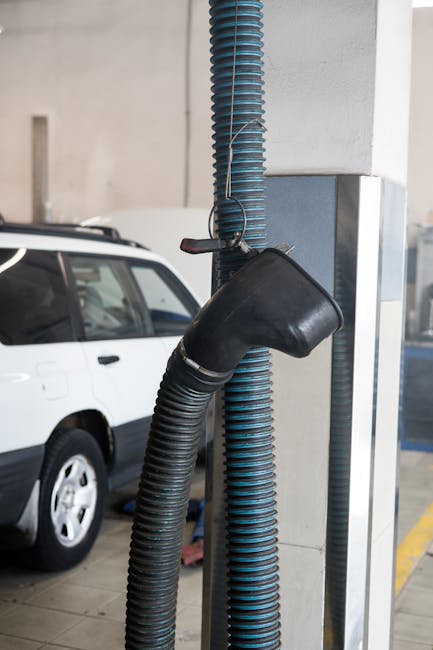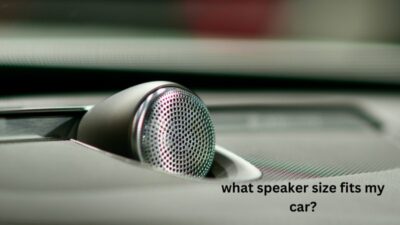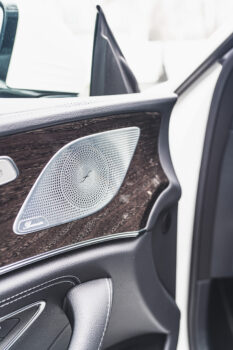How To Check Car Speaker Wire Polarity With Multimeter
Today we discuss Car Speaker Wire Polarity With Multimeter. Are you tired of dealing with poor audio quality in your car? Do you want to upgrade your car speaker system but feel overwhelmed by the technical aspects? Well, fret no more! In this guide, we will walk you through the process of checking car speaker wire polarity using a multimeter. Whether you’re a seasoned car enthusiast or a beginner in the world of car audio, this step-by-step tutorial will equip you with the knowledge and skills to ensure that your speakers are properly wired, resulting in optimal sound performance.
Understanding the polarity of your car speaker wires is crucial for achieving balanced and accurate audio output. When speakers are wired correctly, they produce sound waves that are in phase with each other, resulting in a cohesive and immersive listening experience. However, if the speaker wires are incorrectly connected, the sound quality can suffer, leading to distorted, muffled, or unbalanced audio. By using a multimeter, a versatile tool commonly found in any DIYer’s arsenal, you can easily determine the polarity of your car speaker wires and make the necessary adjustments for optimal audio performance. So, get ready to dive into the world of car audio and discover the secrets to achieving crystal-clear sound in your vehicle!

How to Check Car Speaker Wire Polarity with a Multimeter:
Step 1: Gather the Necessary Tools:
Before you begin, make sure you have the following tools at hand:
- A multimeter
- A pair of wire strippers
- Electrical tape
Having these tools ready will ensure that you can complete the task efficiently and effectively.
Step 2: Turn Off the Car’s Electrical System:
Prior to checking the speaker wire polarity, it is crucial to turn off the car’s electrical system. This will prevent any potential electrical hazards and ensure your safety throughout the process. Make sure the car’s engine is off and the ignition is in the “off” position.
Step 3: Strip the Speaker Wire:
Using a pair of wire strippers, carefully strip a small section of insulation from the end of each speaker wire. This will expose the metal conductor underneath, allowing you to make accurate measurements.
It is important to strip only a small section of the wire to avoid any potential damage or short circuits. Be cautious not to strip too much insulation, as this can lead to unwanted electrical contact.
Step 4: Set Up the Multimeter:
Now it’s time to set up the multimeter to measure the speaker wire polarity. Turn on the multimeter and set it to the “DC voltage” mode. Adjust the range to a suitable level, typically around 20 volts.
Take note of the multimeter’s positive (+) and negative (-) terminals. The positive terminal is usually indicated with a red probe or a “+” symbol, while the negative terminal is indicated with a black probe or a “-” symbol.
Step 5: Connect the Multimeter to the Speaker Wires:
Take one of the stripped speaker wires and connect the multimeter’s positive probe to the exposed metal conductor of the wire. Then, take the other stripped speaker wire and connect the multimeter’s negative probe to its exposed metal conductor.
It is important to ensure a secure connection between the multimeter probes and the speaker wires to obtain accurate readings. Make sure the probes are firmly in contact with the metal conductor.
Step 6: Observe the Multimeter Reading:
With the multimeter properly connected to the speaker wires, observe the reading on the multimeter’s display. If the reading shows a positive voltage, it means that the multimeter’s positive probe is connected to the positive (+) speaker wire. Conversely, if the reading shows a negative voltage, it means that the multimeter’s positive probe is connected to the negative (-) speaker wire.
By correctly identifying the polarity of the speaker wires, you can ensure that the speakers are connected in phase, resulting in optimal sound reproduction and preventing any potential phase cancellation issues.
Step 7: Secure the Speaker Wire Connections:
Once you have determined the polarity of the speaker wires, it is important to secure the connections to prevent any accidental disconnections or short circuits. Use electrical tape to wrap each exposed metal conductor, ensuring that they are well-insulated and protected.
Properly securing the speaker wire connections will also help maintain consistent sound quality and prevent any unwanted interference or noise.
Step 8: Test the Speaker System:
After completing the above steps, it is time to test your car’s speaker system to ensure that everything is functioning correctly. Turn on the car’s electrical system and play some audio through the speakers. If the sound is clear and balanced, you have successfully checked the speaker wire polarity and made the necessary connections.
If you encounter any issues or notice any distortion or imbalance in the sound, double-check the speaker wire connections and repeat the process to ensure correct polarity.
Step 9: Finalize the Installation:
Once you have verified the speaker wire polarity and tested the system, you can finalize the installation by tidying up any loose wires and securing them in place. Use cable ties or adhesive clips to organize the wires and prevent them from interfering with other components or causing any potential hazards.
Ensure that all connections are secure and properly insulated to maintain optimal sound quality and prevent any electrical issues in the future.
Step 10: Enjoy Your Enhanced Audio Experience:
With the speaker wire polarity correctly identified and the system properly installed, you can now enjoy a high-quality audio experience in your car. Whether you’re cruising down the highway or taking a road trip, your car’s audio system will provide clear and immersive sound.
Remember to periodically check the speaker wire connections and perform any necessary maintenance to keep your audio system in top-notch condition.
Faqs for Car Speaker Wire Polarity With Multimeter:
Speaker wire polarity refers to the positive and negative terminals of a speaker wire. It is important because reversing the polarity can affect the sound quality and performance of your car’s audio system. When the polarity is correct, the speakers will produce the intended sound, and the stereo imaging will be accurate.
However, if the polarity is reversed, the speakers may sound muffled, the stereo imaging may be distorted, and the overall audio quality may suffer. Therefore, it is crucial to ensure the correct polarity when connecting speakers to your car audio system.
A multimeter is a versatile electronic device used to measure voltage, current, and resistance. It can also be used to check the polarity of speaker wires. By setting the multimeter to the appropriate mode and connecting the probes to the speaker wire terminals, you can determine whether the wire is positive or negative.
The multimeter will display a positive or negative reading depending on the polarity of the wire. This allows you to identify and correct any polarity issues to ensure optimal audio performance in your car.
To set up a multimeter to check speaker wire polarity, follow these steps:
1. Set the multimeter to the “DC Voltage” mode.
2. Insert the black probe into the COM (common) port of the multimeter and the red probe into the VΩmA (volts, ohms, milliamps) port.
3. Turn on the multimeter and select the appropriate voltage range for your car audio system (typically 12V).
Once the multimeter is set up, you can proceed to check the speaker wire polarity using the probes.
To check the speaker wire polarity using a multimeter, follow these steps:
1. Disconnect the speaker wire from the car audio system to isolate it for testing.
2. Set the multimeter to the “DC Voltage” mode and select the appropriate voltage range.
3. Touch the black probe to the exposed metal part of the speaker wire, and the red probe to the other end of the wire.
4. Observe the multimeter display. If it shows a positive voltage reading, the wire is connected with the correct polarity. If it shows a negative voltage reading, the wire is connected with a reversed polarity.
By following these steps, you can easily determine the speaker wire polarity using a multimeter.
If you discover that the speaker wire polarity is reversed, you can easily correct it by swapping the positive and negative connections. Disconnect the wire from the audio system, identify the positive and negative terminals, and reconnect the wire with the correct polarity.
It is important to double-check the polarity after making the correction to ensure it is now connected properly. This will help optimize the sound quality and performance of your car’s audio system.

Source: pexels.com
conclusion:
understanding how to check car speaker wire polarity with a multimeter is an essential skill for any car enthusiast or audio technician. By ensuring that the positive and negative wires are correctly connected, you can optimize the performance of your car’s audio system and prevent any potential damage. With the step-by-step guide provided in this article, you can confidently and accurately determine the polarity of your car speaker wires using a multimeter. Remember, proper polarity is the key to achieving high-quality sound reproduction and an immersive audio experience while on the road.
By taking the time to check the polarity of your car speaker wires, you can avoid common issues such as phase cancellation, distorted sound, or even potential damage to your audio equipment. Whether you are installing a new speaker system, troubleshooting an existing one, or simply ensuring that your car’s audio is functioning at its best, using a multimeter to check wire polarity is a straightforward and effective method. So, grab your multimeter, follow the steps outlined in this article, and embark on a journey of superior audio quality and enjoyment in your car. Happy listening!






